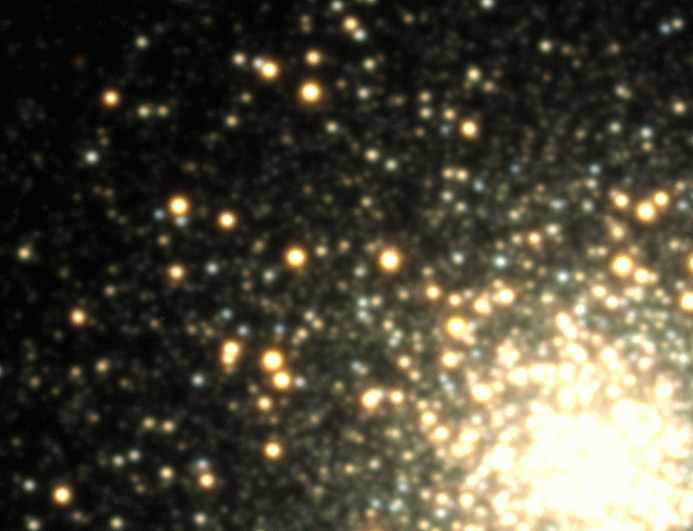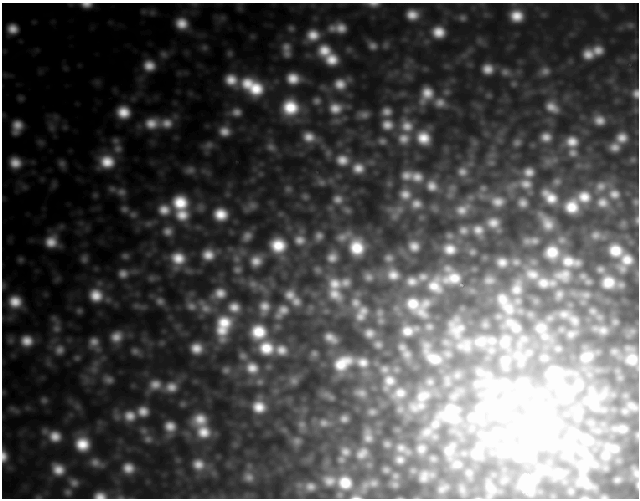M3 Variable Star Movies
The globular cluster M3 (NGC 5272) is extremely rich in variable stars, particularly in RR Lyrae (it is the most RR Lyrae-rich galactic globular cluster, with over 200 of these stars). See, for example, The Catalog of Variable Stars in Globular Clusters by Clement et al. 2001. Another listing of variables stars in M3 is given by Bakos et al. 2000.
In fact, because globular clusters contain so many RR Lyrae, these variables were once known as "cluster variables." So what are RR Lyrae? The simple answer is that they are pulsating stars that lie on the intersection of the Classical Instability Strip and the Horizontal Branch in the color magnitude diagram, as shown in this image of the M3 CMD, where the RR Lyrae are shown as blue dots. In other words, they are giant stars that are in the process of fusing helium into carbon and oxygen in their cores and hydrogen into helium in an envelope surrounding the core. They are stars with a temperature profile that is just right to make them unstable to pulsations - the cause is essentially the same as for the more famous Cepheids which are used to find the distance to nearby galaxies. Like Cepheids, once metallicity effects have been accounted for, RR Lyrae are good standard candles. In this case one is measuring the absolute magnitude of the horizontal branch, itself a standard candle. RR Lyrae are particularly useful in determining the distance to globular clusters, and have even been used to measure the distance to the magellanic clouds, where the Cepheid distance scale is calibrated.
RR Lyrae often have amplitudes of variation as high as 1 magnitude in V, and even higher in B. The RRab stars (fundamental mode pulsators) are the most numerous and have periods of roughly half a day. The RRc stars (first overtone pulsators) have periods of roughly a third of a day. What's more, because they are among the brightest stars in a globular cluster, they're actually very conspicous. If you were to watch them over the course of a night you would see quite a beautiful show, with the RR Lyrae blinking "on" and "off" like Christmas lights. Below are some movies constructed from actual observations of M3 that show just that. The observations were made by Krzysztof Stanek and Andrew Szentgyorgyi over the course of one night in 1998 on the 1.2 m. telescope at F.L. Whipple Observatory in Arizona.

The above movie was created from 4 images in 3 filters (BVI) taken over the course of a single night. For each filter the seeing and background of all the images was matched to a reference using the Image Subtraction techniques due to Alard & Lupton. The separate filters were then combined after subtracting the background measured around a star with B-V~0 V-I~0 in the Landolt standard system, and rescaled so that the star would appear white in the combined image. For the red channel an approximate R-band image was created using the geometric mean of the V and I band images. One can see clearly the vast number of RR Lyrae in this image, and can also notice the characteristic color change in these variables - they become bluer as they get brighter. Notice also that the RR Lyrae appear to have a uniform average brightness (i.e. there are not any very bright stars that are RR Lyrae, and not many very dim stars that are RR Lyrae), since these variables are all at the same distance, this observation illustrates the fact the RR Lyrae are good standard candles.

The above movie was created from 4 images in the B-band taken over the course of a single night. The images were processed as above without combining with the R and V filters. Note that the scales used in this image are not the same as above (i.e. this is not just the movie above with the R and G channels switched off). The number of RR Lyrae is even more apparant in this movie, particularly toward the core of the globular cluster.
Joel D. Hartman
Last modified: Thur Sep 1 02:20:32 EDT 2011

